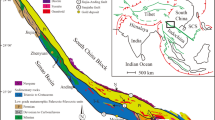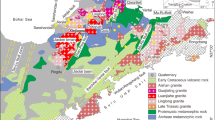Abstract
By studying both the microscopic physical and chemical typomorphic characteristics of typical mineral pyrite samples associated with representative gold deposits on the north-central margin of the North China Platform, this paper seeks to identify macroscopic metallogenic mechanisms of gold deposits and to reveal the formation mechanism of lattice gold in pyrite. Typomorphic characteristics of pyrite reveal that pyrite grain size has a negative correlation with gold content. Cubic pyrite, as the dominant crystal form, contains more gold than pentagonal dodecahedral pyrite. Both pyrite crystal forms and chemical compositions indicate that the replacement style of gold deposit formed in a low saturability, low sulfur fugacity, and at temperatures either much higher or much lower than its best forming temperature; comparatively, that of the quartz vein style of gold deposit occurred under conditions with the best temperature, rich in sulfur, and with high sulfur fugacity. The Au/Ag ratios of the pyrites show that both the replacement and quartz vein styles of deposits are mesothermal and hypothermal, while the Co/Ni ratios of the pyrites indicate that the quartz vein style is of magmatic-hydrothermal origin. The X-ray diffraction intensity of pyrite rich in gold is lower than that of pyrite poor in gold at the quartz vein style. In general, with an increase in gold content in pyrite, the total sum intensity ΣI decreases. The pyroelectricity coefficient has a negative correlation trend with the values of (Co + Ni + Se + Te)-As and (Co + Ni + Se + Te)/As. The pyrite pyroelectricity of the replacement style is N-type, indicating that it formed under low sulfur fugacity, while that of the quartz vein style is a mixture of P-N types, indicating that it formed under high sulfur fugacity. On the pyroelectricity-temperature diagram, pyrite of the replacement style is mainly distributed between 200 and 270 °C, while that of the quartz vein style varies between 90–118 and 274–386 °C, demonstrating a multistage forming process. In contrast to previous researchers’ conclusions, the authors confirm the existence of lattice gold in pyrites through the use of an electron paramagnetic resonance (EPR) test. Au in the form of Au+, entering pyrite as an isomorph and producing electron–hole centers, makes the centers produce spin resonance absorption and results in EPR absorption peak II. The intensity of auriferous pyrite absorption peak II has certain direct positive correlations with pyrite gold content. The #I and #III absorption peaks of pyrites possibly result from the existence of Ni2+ and/or Cu2+. γ1, γ2, and γ3 are the strongest and most typical absorption peaks of the infrared spectra of the pyrites. Generally, with the increase in gold content in the pyrite samples, γ1, γ2, and γ3 tend to shift to higher wavenumbers, and the gold content in the pyrite samples has a positive correlation with their relative absorbance.

















Similar content being viewed by others
Data availability
The data that support the findings of this study is available from the authors upon reasonable request.
References
Adams SS, and Putnam III BR (1992) Application of mineral deposit models in exploration: a case study of sediment-hosted gold deposits, Great Basin, western United States. In: Case histories and methods in mineral resource evaluation. Geological Society, Special Publication Number 63, pp 1–23
Arehart GB (1996) Characteristics and origin of sediment-hosted disseminated gold deposits: a review. Ore Geol Rev 11:383–403
Azzaman MA, Idrus A, Titisari AD (2021) Geology, hydrothermal alteration and mineralization of the Carlin-type gold deposit at South Ratatotok, Southeast Minahasa Regency, North Sulawesi Province, Indonesia. In: IOP conference series: Earth and environmental science, pp 1–9. https://doi.org/10.1088/1755-1315/789/1/012076
Barton MD, Seedorff E, Ilchik RP (1997) Contrasting siliceous replacement mineralization. Society of Economic Geologists, Society of Economic Geologists Guidebook Series. East-Central Nevada. https://doi.org/10.5382/GB.28
Chao Y, Yin J, Yin Y, Shi H, **ang S (2022a) Occurrence state and properties of gold minerals from the gold deposits on the North China platform. European J Appl Sci. https://doi.org/10.14738/aivp.105.13292.10(5)2022,504-513
Chao Y, Yin J, Yin Y, ** gold deposit in the northern margin of the North China Platform. Eur J Appl Sci. https://doi.org/10.14738/aivp.106.13391.10(6)2022,38-47
Chen G (1987) Minerageny and prospecting mineralogy. Chongqing Publishing House, Chongqing (in Chinese)
Dang J (1991) The application of EPR spectra of quartz to the evaluation of gold ore deposits. Acta Petrologica et Mineralogica 10(1):68–73 (in Chinese with English abstract)
Dong J (1989) Genesis of gold deposits in the northern Hebei & western Liaoning Provinces, China. Geol Prospect 9:22–23 (in Chinese with English abstract)
Gao M (1991) Geochemistry of the Archean granulite facies metamorphic rocks in the Zhangjiakou-Xuanhua region, China. Geol Prospect 9:16–22 (in Chinese with English abstract)
Garwin SL, Hendri D, Lauricella PF (1995) The geology of the Mesel sediment-hosted gold deposit, North Sulawesi, Indonesia. In: Proceedings of the PACRIM congress 1995. Australian Institute of Mining and Metallurgy, pp 221–226
Hu D (1993) The significance of electron and hole centers in the assessment of gold deposits. Acta Petrologica et Mineralogica 12(4):356–362 (in Chinese with English abstract)
Hu X, Zhao J, Li S (1990) Gold mineralization in the Archean metamorphic rocks in the Zhangjiakou-Xuanhua region, China. J Tian** Inst Geol Miner 22:2–9 (in Chinese with English abstract)
** S, Li H (1985) Brief introduction to minerageny. Jilin University Publishing House, Changchun (in Chinese)
Jones RS, Fleischer M (1969) Gold in minerals and the composition of native gold. Geological Survey Circular 612, United States Department of the Interior, pp 1–17
Kingston SP (2009) Nature and origin of gold-rich carbonate replacement deposits at the Rau occurrence, central Yukon. A thesis submitted in partial fulfilment of the requirements for the degree of bachelor of (geological) science (honours). This thesis conforms to the required standard. Supervisor: the University of British Columbia, Vancouver, BC
Li R (1992) Geology, geochemistry and metallogenic model of the Hougou gold deposit in Hebei Province, China. Geol Prospect 3:46–50 (in Chinese with English abstract)
Liu C (1997) The application of EPR and infrared spectra of quartz to the prospecting and evaluating of gold deposit in the middle Jiangxi province of China. J East China Geol Inst 20(4):313–318 (in Chinese with English abstract)
Lobato LMM, Vieira FWR (1998) Styles of hydrothermal styles of alteration and gold mineralization associated with the Nova Lima group of the QUADRILÁTERO FERRÍFERO: PART II, The Archean Mesothermal gold-bearing hydrothermal system. Revista Brasileira De Geociências 28(3):355–366
Percival TJP, Radtke AS, Bagby WM (1990) Relationships among Carbonate-Replacement Gold Deposits, Gold Skarns, and Intrusive Rocks, Bau Mining District, Sarawak. Malaysia. Min Geol 40(1):1–16
Poulsen KH, Robert F, Dubé B (2000) Geological classification of canadian gold deposits. Geol Surv Can Bull 540:1–113
Ravenelle JF (2013) Amphibolite facies gold mineralization: an example from the Roberto deposit, Eleonore property, James Bay, Quebec. Thèse. Québec, Université du Québec, Institut national de la recherche scientifique, Doctorat en sciences de la terre
Roberts, RJ (1986) The Carlin story. In: Tingley JV, Bonham Jr HF (eds) Sediment-hosted precious metal deposits of Northern Nevada. Nevada Bureau of Mines and Geology, Report 40, pp 71–80
Shao J (1990) Prospecting mineralogy of gold deposits. China University of Geosciences Publishing House, Wuhan (in Chinese)
Sillitoe RH (2020) Carlin-type and distal-disseminated gold deposits: A carbonate-replacement deposit perspective. In: October 2020 conference: vision for discovery. Geology and ore deposits of the basin and range. Geological Society of Nevada, Reno
Sillitoe RH, Bonham HF Jr (1990) Sediment-hosted gold deposits: distal products of magmatic-hydrothermal systems. Geology 18:157–161
Song R, Wang Y, Wang Z (1994) Geology of the lode gold deposits in Hebei Province, China. Geological Publishing House, Bei**g (in Chinese)
Valette MDSS, Mercier-Langevin P, Côté-Mantha O, Simard M, Wodicka N, McNicoll VJ, Barbe P (2020) Lithological and tectonic controls on banded iron formation-associated gold at the Amaruq deposit, Churchill Province, Nunavut, and implications for exploration. Targeted Geoscience Initiative 5: contributions to the understanding of Canadian gold systems. Geological Survey of Canada, Open File 8712, pp 251–266. https://doi.org/10.4095/326042
Wang S (1986) Genetic research of the gold deposits in the Zhangjiakou-Xuanhua region, China. J Peking Univ (Nat Sci Ed) 4:81–89 (in Chinese with English abstract)
Wang H, Chen S (1996) Characteristics of the EPR spectra of quartz from the Heilongtan gold deposit in Suizhou, Hubei Province of China. Hubei Geol 10(1):75–78 (in Chinese with English abstract)
Wang J, Yin J, Chao Y, Yin Y, **ang S, Shi H (2022) Structural control of gold deposits in the northern margin of the North China Platform. Eur J Appl Sci. https://doi.org/10.14738/aivp.106.13390.10(6)2022,29-37
**ang S (1991) Preliminary research on the geology of the Hougou-type gold deposit. Geol Prospect 3:15–20 (in Chinese with English abstract)
Xu H, Liang R, Zhao J, Yang Y, Liang Y (2014) Geological characteristics of the gold triangle region and its prospecting target, Hebei Province, China. Miner Explor 5(1):14–20 (in Chinese with English abstract)
Yin J, Shi H (1995) Geology of the gold deposits in the Zhangjiakou-Xuanhua Region China. Geological Publishing House, Bei**g, pp 42–59 (in Chinese with English abstract)
Yin J, Zhai Y (1994) Metallogenic series of gold deposits in the Zhangjiakou-Xuanhua region of Hebei Province, China. J Guilin Coll Geoly 14(4):359–369 (in Chinese with English abstract)
Yin J, Liu Y, Shi H (2021) Chemical and physical characteristics of quartz from gold deposits in the North China platform: relationship to gold mineralization. Acta Geochimica 40(6):998–1022. https://doi.org/10.1007/s11631-021-00487-x
Zhang Q (1984) Geology and metallogeny of the early Precambrian in China. Jilin People’s Publishing House, Changchun (in Chinese with English abstract)
Zheng Y (1990) Structural research on the Dong** gold deposit in Chongli County, Hebei Province, China. Geol Prospect Rev 2:20–27 (in Chinese with English abstract)
Acknowledgements
Support for this study was received from the China National Ph.D. Foundations and from Prof. Yusheng Zhai of China University of Geosciences, also an Academician of the Chinese Academy of Sciences, and from Prof. Zhaolu Pan and Jianhong Zhang of China University of Geosciences in Bei**g, who provided insightful discussions and critical reviews of this manuscript. The chemical analyses, electron microprobe tests, X-ray diffraction, pyroelectricity tests, and infrared spectroscopic analyses of the pyrites were carried out at the labs of the China University of Geosciences in Bei**g, while the EPR test was performed in the lab of the Department of Physics, Peking University, China. The authors very much appreciate the time invested by Mr. S. Daly, P. Geo of APEGBC, Canada; Mr. M. Storey, M. Eng. and P. Eng. with APEGBC of Canada and by David Yin, BSc of USA, for their review and editorial work on this contribution.
Author information
Authors and Affiliations
Contributions
The entire study included in the paper was proposed and organized by JY and SY, who should be regarded as co-first authors. Many of the figures and tables were prepared by HY, HS, JS, YC, and SX, who also helped the two co-first authors with the whole research. HS and SX helped complete the chemical analyses of this study. All authors prepared and reviewed the manuscript and approved the final version. Conceptualization, JY; Investigation, JY, SY, HY, HS, YC, and SX; Project administration, SY, HY, HS, YC, and SX; Writing—original draft, JY and JS.
Corresponding author
Ethics declarations
Conflict of interest
The authors declare that they have no conflict of interest.
Rights and permissions
Springer Nature or its licensor (e.g. a society or other partner) holds exclusive rights to this article under a publishing agreement with the author(s) or other rightsholder(s); author self-archiving of the accepted manuscript version of this article is solely governed by the terms of such publishing agreement and applicable law.
About this article
Cite this article
Yin, J., Sun, Y., Yin, H. et al. Correlations between trace elements in pyrite and gold mineralization of gold deposits on the North China platform. Acta Geochim 42, 1079–1103 (2023). https://doi.org/10.1007/s11631-023-00636-4
Received:
Revised:
Accepted:
Published:
Issue Date:
DOI: https://doi.org/10.1007/s11631-023-00636-4




